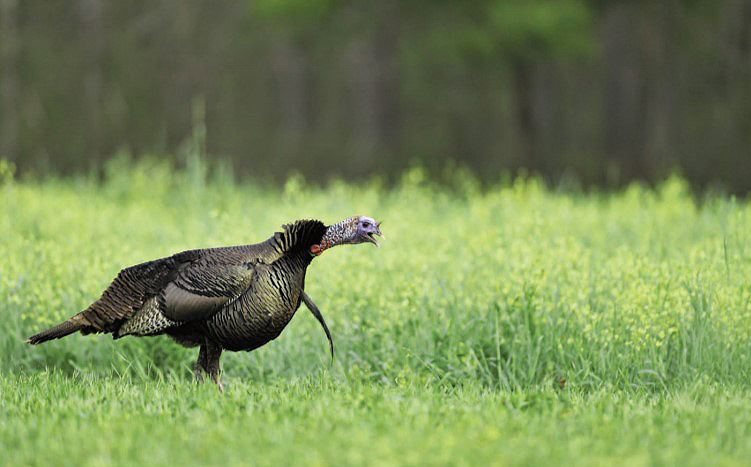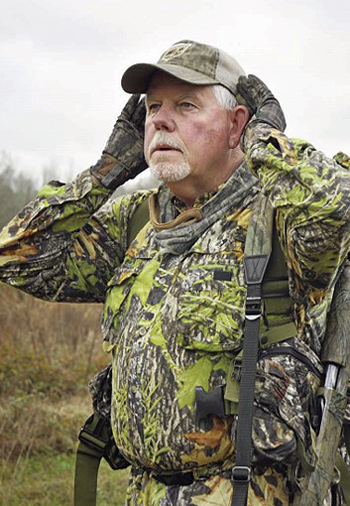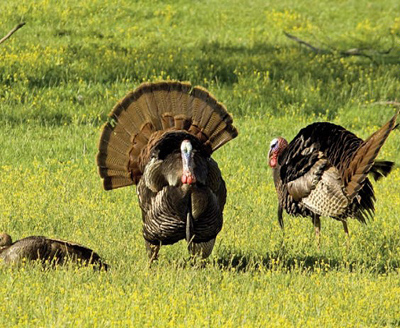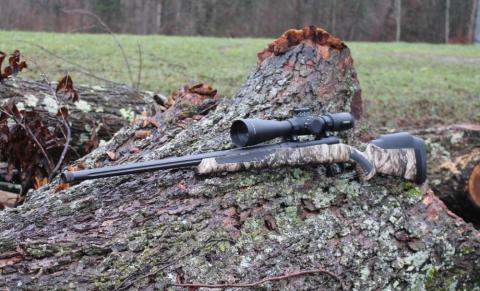Ron Jolly | Originally published in GameKeepers: Farming for Wildlife Magazine. To subscribe, click here.
I remember being cold! I remember the fog on the Tensas River in northeast Louisiana hung like a thick blanket in the air. The myriad of sound coming from the hardwood forest on the river’s bank was a bit confusing to my ears. The waves lapping on the side of an old Jon boat was another distraction. My Dad sat in the stern of the boat and I sat on the middle seat with his best friend Mr. Sonny Hudnall. I remember straining my ears to hear a sound they were hearing that I could not. Their mission was for me to hear my first wild turkey gobble. Again Mr. Sonny asked, “Did you hear that?” Sure, I thought. I hear water on the side of the boat, birds in the trees, water dripping off the trees into the river. “Did I hear what?” was my answer. “It will sound like oble, oble, oble,” said Mr. Sonny.
I strained to hear the sound and finally thought I did. “Was that him?” I asked. My Dad leaned close to my ear from behind and said, “Son, that was the turkey you just heard. He has gobbled six times since we have been here. He is about a quarter-mile away. You just have to learn to separate all the sounds from the sound you want to hear. Focus on that sound and you will hear it clearly. The secret to hearing is in the listening!”
That morning was the first time I heard a wild turkey gobble. There have been many lessons learned about wild turkeys since that morning over fifty years ago, but none as important as how to listen for, and hear turkeys. Here are some tips that will help you.
Easy Access Gear Available at Walmart: Mossy Oak Turkey Strap Vest

Know What You Are Listening For
Learning what to listen for is the first step to hearing more turkeys. The gobble of the wild turkey is one of the most unique sounds in nature. To the experienced turkey hunter there is no other sound that can be confused with a gobble. To the novice it is a sound that can be hard to discern, especially when it is far away. Even harder to detect are the more subtle sounds made by turkeys such as drumming, yelps, and scratching in leaves. All these sounds can tell you that turkeys are near.
There are three places turkeys make sounds—when they are in the tree, when they are flying into or out of the tree, and when they are on the ground. Turkeys gobble, yelp, cackle and drum in the tree and on the ground. Turkey hens often cackle when flying up to or down from the roost. The thump of wings is another distinct sound made by turkeys. In most cases a gobble in the tree has a different sound than a gobble made on the ground. It is clearer and less muffled.
As a general rule a gobble made in a tree can be heard twice as far as one made on the ground. That same “twice-as-far” rule applies to all other turkey sounds.

Judging distance and coursing sound are other factors in turkey hunting success. Hearing a turkey sound and identifying that sound is step one.
To successfully hunt that turkey you must know the direction the sound came from and how far away it was. The first step to hearing more turkeys is to know what turkeys sound like. Experience and exposure to turkeys can teach you what to listen for. A better way is to watch other hunters. Videos and DVDs put you in the woods with experienced hunters.
Listen to the sounds on the DVDs and learn how turkeys sound in the wild from your living room. Some companies offer videos dealing with nothing but turkey sounds and identifying what each sound is and what it means.
Isolate and Concentrate

mouth. This gathers more sound into your ears.
Obviously, you can’t hear behind you as well, but it
helps to collect more sound-waves and pinpoint
where it is coming from.
The second step to hearing more turkeys is to isolate yourself from any distracting noise. If you are listening with a hunting partner, distance yourself from your partner. This will eliminate any distracting sounds they make or the temptation to talk. It also helps to triangulate the sound's direction.
Choose a listening place where you can stand or sit motionless and be comfortable. I like to rest my back against a tree or sit on a log. I do not shuffle my feet in the leaves and I do not tinker with gear. I focus on hearing turkeys. You probably think I am talking only about hearing a gobble, and that is true for the most part, but eliminating any distracting noise applies when you are listening for turkey sounds in general.
Sound Advice
Two-time World Turkey Calling Champion Larry Norton is an experienced turkey hunter who has spent years guiding clients at commercial hunting operations like Bent Creek Lodge in Alabama. Norton offers some good advice on hearing more turkeys. “I guide hunters who have hunted for years and hunters who are hunting turkeys for the first time. It is our job to get each hunter on a turkey and hopefully get that hunter a shot. That all starts with hearing, coursing and getting into position on a gobbler,” says Norton.
“I like to start on high ground. From there I can hear more country. Many of my clients like to stand close or talk while we are listening for a roosted gobbler. I simply tell them in order to start the hunt we have to first hear a gobble and I can do that best when there are no distractions. Most hunters understand this and give me space.”
“At this point we are listening at day break for sounds turkeys make in the tree. We are primarily listening for a gobble but other sounds can disclose where turkeys are. If I hear hens tree yelping, cutting or plain yelping I know where a flock is located. I hope to hear a gobble, but if I do not I still assume a gobbler is near. If I do not hear a gobble at another location I will go to the hens and hope a gobbler will fire up after the flock flies down. At least I know I have put my client near turkeys,” says Norton.
“There are times when you do not hear turkeys on the roost and this is when you have to change tactics. I go to an area where turkeys frequent and slow way down. I move a few yards and stop to listen. I like to slip to near the top of a ridge where I can hear into the next hollow. I use the ridge to keep turkeys from seeing my approach. Now I am listening for sounds other than gobbles. “I listen for the distinct swish, swish, swish of turkeys scratching in leaves or for drumming. Turkeys are constantly making soft purrs, whines and yelps. This helps keep the flock together and these sounds cannot be heard from very far away. Many times if you hear these sounds and listen really closely you will hear drumming. When you hear any of these sounds set up right there. The turkeys are close!”
Cheat Norton also uses a Walker Game Ear to enhance his hearing ability. He cautions that there is a learning curve associated with mechanical hearing devices. “You have to learn to course with the Game Ear,” says Norton. “You also have to realize that sounds you hear using a mechanical device are always further away than they seem. I use the Game Ear to get in the general area of a turkey then rely on my own ears to close the deal but I know people who use them the entire hunt. It depends on you.”
My wife, Tes, suffers from hearing loss and uses mechanical hearing devices made by E.A.R., Inc. “I put them in before I leave in the morning and take them out when my hunt is over,” said Tes. “I cannot do without them. It was frustrating at first because all sounds are magnified. The sound of your steps, the birds, the wind, traffic, everything! I really had to work at getting used to them, but it was worth the effort.”

up when possible and from the leeward side of cover when
there’s a wind.
“Coursing and judging distance were also challenging, but in time it all came together. It really helped to go with someone who could hear well and compare what I thought I was hearing to what that person was hearing. After only a few outings I gained confidence in my ability to hear, course, and judge the distance to that sound. I never go hunting without them,” said Tes.
There are other ways to enhance the ability to hear more turkeys. Cup your hands behind your ears to gather more sound into your ears. You will be able to hear better in the direction you are facing but not as well in other directions. Turn your body to listen in all directions. Open your mouth while listening. This opens the ear canal and allows more sound into the ear. Slow your breathing. Take shallow breaths with your mouth open. This reduces the sound of air moving in and out of your lungs and eliminates some of the noise that competes with your ability to hear. Close your eyes. This helps you concentrate on hearing and eliminates visual distractions going on around you.
Avoid direct contact with the wind if at all possible. On windy days listen from the down-wind side of a ridge or hill. Face into the wind and allow the wind to bring sound to you. I am blessed with good hearing ability but I carry a single over-the–ear device made by Woodland Whisper that I use when I cannot hear turkeys with my own hearing. Often that device allows me to hear a gobbler that I could not hear naturally. Problem is, that turkey is usually too far away to get to. If that turkey is on the property I can hunt I will be there to listen next time.
Easy-Access Gear Available at Your Local Walmart: Men's Stretch Cargo Turkey Pants in Mossy Oak Obsession
Common Sense
Never listen near running water, traffic, or construction. Avoid any foreign noise that competes with your ability to hear turkeys. Move as far away from distracting noise as possible. Be aware of the time of day. Turkeys generally fly up to roost near sundown. Turkeys generally fly down from their roost as soon as they can see the ground. It is important to know if a turkey is on the ground or in a tree because a gobble from roost can be heard farther than a gobble on the ground.
Hearing a turkey gobble in the rain is challenging at best. If you’re confident of the path that turkeys take on your hunting property, set up a ground blind. A ground blind is an excellent way to hunt turkey in the rain. Your gear and calls can stay dry while you wait on a gobbler to respond. Turkeys, in general, are not as vocal as usual when it’s raining, so they need to be close to respond to your call. You will want to call more than normal as the rain makes it hard for hunters and gobblers to hear.
If you know where a gobbler roosts at night, set up nearby the following morning. In the west, using binoculars or spotting scopes can help you track a turkey’s movements in the evening. If you are in an area where timber prevents you from using optics to track turkey, you can use a locator call to find them. A locator call like an owl call used in the evening can get a gobble response from a roosted tom. Once you get an answer, plan your morning sit accordingly. Knowing where a gobbler is roosted will help you hear him the next morning.
Before you can expect a gobbler to respond, you have to be proficient with your turkey calls. If what you are producing is not realistic, you may not get a response. Worse, you may scare the turkey away. Work with all your calls until you are proficient with the clucks, yelps, putts and purring that a hen might make.
The Secret to Hearing is in the Listening
It is my firm belief that the key to turkey hunting success is the ability to “hear turkeys.” When you hear and identify a turkey sound you can judge where the turkey is, how far away he is and the direction he is moving. This information tells you where you need to go. Very few turkey hunts end with a turkey in your vest that did not start by first hearing turkeys. Learn how turkeys sound. Put yourself in the best position to hear and concentrate. Do this and you will hear more turkeys!




















